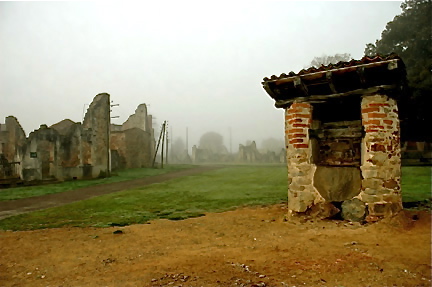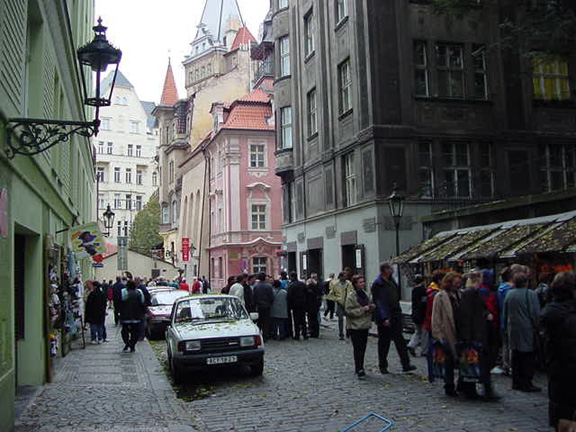
Dachau triangle sculpture has no black triangle (1997 photo)
According to the current news, the mentally and physically disabled in Nazi Germany wore a black triangle in the concentration camps.
The Huffington Post has an article about the planned memorial to the victims of the Nazi euthanasia program in Germany which you can read here. This quote is from the article:
Adolf Hitler saw no place for the mentally and physically disabled in his vision of a “racially pure” Germany, just as he saw no place for Jews, Sinti and Roma and homosexuals.
You can read about the euthanasia program at Hartheim Castle in Austria on my website here.
I took the photo above, in May 1997 at Dachau, on my very first visit to a Memorial Site in a former Nazi concentration camp. That’s when I learned for the first time about how the prisoners were classified according to several categories.
At Dachau, in 1997, there was nothing in the Museum about handicapped people being put into a concentration camp and forced to wear a black triangle.

Close-up of triangle sculpture at the Dachau Memorial Site (1997 photo)
Non-Jewish Polish forced laborers at Dachau wore a blue triangle, as shown in the photo above. A purple triangle was worn by the Jehovah’s Witnesses.
A bar over the triangle denoted a person who had been released and then incarcerated again for a second offense. A dot below the triangle meant that the prisoner was in the punishment detail and had to perform hard labor. Note the red dots in the sculpture.

Another section of the Dachau Triangle sculpture
The vast majority of the prisoners at Dachau were political prisoners from other countries, primarily Communists and illegal combatants who continued to fight after their countries were conquered; they wore a red triangle, pointing downward. A red triangle pointing upward was for a German political prisoner, but they are not included in the Dachau sculpture.

Monument at Sachsenhausen Memorial Site shows only red triangles in honor of the Communist prisoners (1999 photo)
Inside the Museum at Dachau, in 1997, was a poster, which is shown in the photo below.

Poster shows the various badges worn by prisoners to designate their category
The top row of triangles in the photo above shows all the colors of the badges worn by the prisoners in all the Nazi concentration camps.
Red was for Communists, Social Democrats, anarchists, and other “enemies of the state.” Green was for German criminals who had committed two or more crimes. Blue was for foreign forced laborers; brown was for Gypsies; pink was for homosexuals; purple was for Jehovah’s Witnesses.
Black was for a-socials, a catch-all term for vagrants, bums, prostitutes, hobos, perverts, alcoholics who were living on the streets, or anyone who didn’t have a permanent address. The “work-shy,” or those who were arrested because they refused to work, also wore a black badge.
Before 1942, Gypsy men wore a black triangle in the concentration camps. At that time, Gypsy men were arrested and imprisoned for being a-social if they didn’t have a permanent address, or they were arrested for being “work-shy” if they were not employed.
Every male citizen in Nazi Germany, who was capable of working, was required to take a job and they were not allowed to quit their job without permission. Gypsy women were arrested under the a-social category if they were prostitutes.
When I visited the Sachsenhausen Memorial Site in 1999, I learned more about the triangles that were worn by the prisoners.
According to information presented at the Sachsenhausen Museum, Jewish prisoners always wore two triangles: one was a yellow triangle, with another triangle of a different color sewn on top of it, to form a six point star.
Jewish political prisoners wore a yellow triangle with a red triangle on top. Jews who wore a white triangle over a yellow one were called Jüdisher Rassenschänder. A black triangle designated an a-social (Asozialer). A Jewish a-social was a Jüdisher Asozialer who wore a black triangle over a yellow one. A green triangle meant a criminal who was a repeat offender; Jewish criminals wore a green triangle over a yellow one and were called Jüdisher Befristeter Vorbeugeshäftlinge or Jewish prisoners in limited preventive custody.
The Jehovah’s Witnesses (Bibelforscher) wore purple triangles, and the Sinti and Roma (Gypsies) wore a brown triangle. The work-shy (Arbeitsscheuer) wore white triangles at Sachsenhausen. Non-Jewish race defilers, or those who broke the 1935 Nürnberg laws against race mixing, wore a triangle with a black border around it.
Because Sachsenhausen was near Berlin, which was the mecca for homosexuals at that time, Sachsenhausen was the concentration camp that had the most homosexual prisoners of any of the Nazi camps. Homosexuals wore a pink triangle (Rosa Winkle).
On my visit to the Dachau Memorial Site in 1997, I learned that prisoners who were terminally ill were sent to Hartheim Castle for mercy killing. A doctor had to sign the order, giving the cause of the illness.

Hartheim Castle in Austria was where severely handicapped people were killed.
None of the former concentration camps, that I have visited, had a display that included a black triangle worn by a handicapped person. That is why I was very surprised to read a news article about a memorial that is soon going up in Berlin, in honor of the handicapped people who wore black triangles in the concentration camps, where they were killed. This is news to me!

Proposed “euthanasia monument” will be a blue wall
This quote is from the news article, which you can read in full here:
New Berlin memorial revives memories of doctors’ role in Nazi holocaust
By Dr. Peter Saunders
Editor’s note. Dr. Saunders is a former general surgeon and is CEO of Christian Medical Fellowship, a UK-based organization with 4,500 UK doctors and 1,000 medical students as members.
Officials gathered in Berlin [in early July] to lay the foundations for a monument to the people killed as part of the Nazi ‘euthanasia’ programs.
The symbolic site at Tiergartenstrasse 4 was chosen as it was the headquarters of the original project.
The planned exhibit will be dedicated to the victims of the ‘euthanasia’ program, codenamed ‘T4’, used by the Nazis to kill those with physical or mental illnesses.
It will be situated not far from a memorial to the six million Jewish victims of the Holocaust opened in 2005 and a memorial to the half a million Roma victims of the Nazis opened in 2012.
Between January 1940 and August 1941 about 70,000 people were killed under the T4 programme. Many were sent to gas chambers, others were killed by lethal injection.
The programme was ostensibly shut down in 1941, partly after church protests, but it continued in secret. Historians estimate that between 200,000 and 300,000 people who were either psychotherapy patients or physically disabled were killed altogether.
The planned monument will be a long, blue glass wall – designed by the architects Ursula Wilms and Heinz W. Hallman, along with the artist Nikolaus Koliusis and the federal government plans to contribute 500,000 euros ($643,200) to the costs.
The finished site is tentatively scheduled for inauguration in the second half of 2014. […]
Many still fail to appreciate the role of doctors in the Nazi holocaust but what ended in the 1940s in the gas chambers of Auschwitz, Dachau and Treblinka had much more humble beginnings in the 1930s in nursing homes, geriatric hospitals and psychiatric institutions all over Germany.
When the Nazis arrived, the medical profession was ready and waiting.
The medical and other healthcare staff from T4 and the early killing centres based in hospitals were later redeployed for the killing of Jews, Gypsies, Poles, Russians and disloyal Germans. By 1943 there were 24 main death camps (and 350 smaller ones) in operation. […]
Britain’s Black Triangle Campaign, which was set up to combat discrimination against disabled people, uses as its symbol the ‘black triangle’ which the Nazis forced people with mental and other disabilities to wear in the extermination camps during the Holocaust.
The generic classification they used was ‘arbeitsscheu’ – literally ‘workshy’.
The lessons are clear. The holocaust had small beginnings and advanced in a series of imperceptibly small steps. The medical profession accepted its basic premises (that there is such a thing as ‘a life not worth living’ and that killing such people was ‘an act of mercy’) and failed to protest whilst a small section of its members actively acquiesced to involvement.
The Nazi euthanasia program began in August 1939 when a five-month-old baby boy, named Gerhard Kretschmar, was “put to sleep” after the boy’s father made a request to Adolf Hitler for a “mercy killing.” Hitler sent his personal physician, Karl Brandt, to conduct a medical examination before giving his permission for the infant to be given a lethal injection.
Karl Brandt was put on trial at Nuremberg in the “Doctor’s Trial.” In his testimony, Brandt said that the baby’s father, Richard Kretchmar, had written to Hitler’s office in early 1939, asking for permission to kill his blind and deformed son. The following quote is from Brandt’s testimony:
“The father of a deformed child wrote to the Fuhrer with a request to be allowed to take the life of this child or this creature. Hitler ordered me to take care of this case. The child had been born blind, seemed to be idiotic, and a leg and parts of the arm were missing.”
An estimated 8,000 deformed children were killed in the same manner, some without the consent of their parents.
The Nazi euthanasia program was code-named T4, named after the address on Tiergartensstrasse in Berlin; this was the street address of the Privatkanzlei des Führers run by Philip Bouhler. This is approximately where the new memorial to the victims, who were killed in the euthanasia program, will be located.
By the beginning of 1940, six hospitals were involved in these “mercy killings.” Records discovered in 2003 show that the euthanasia program was eventually extended to 296 medical facilities in Germany, Austria, the Czech Republic and Poland, where mentally and physically disabled children and adults were injected, gassed or starved to death.
The Nazis made a documentary film of some of the adult victims before they were killed; this was an attempt to justify the murder of disabled and deformed people. Many of the victims, who were crippled by a birth defect called spina bifida, are shown in the film, walking on all fours. This film is not shown at the Hartheim Memorial Site. The film used to be available on the Internet, but is no longer shown.












































